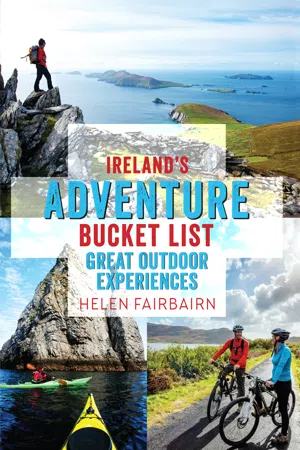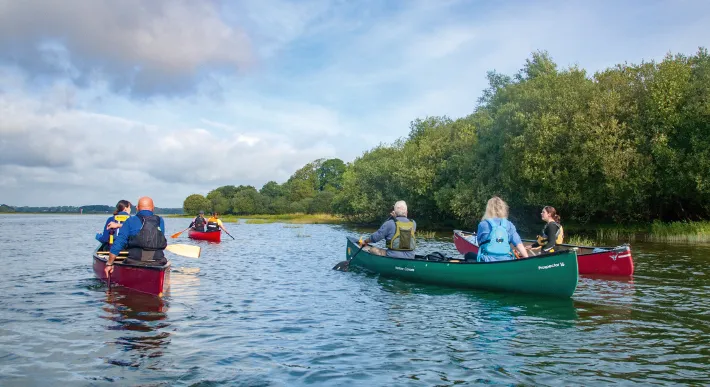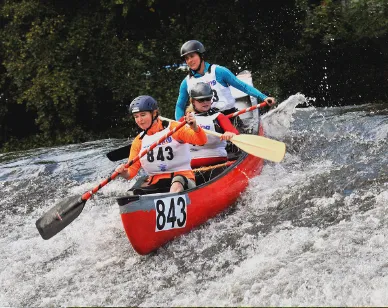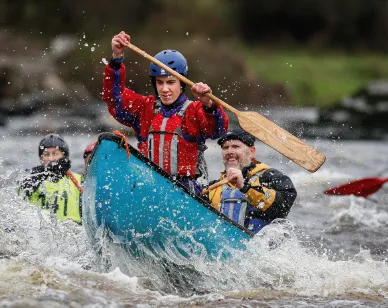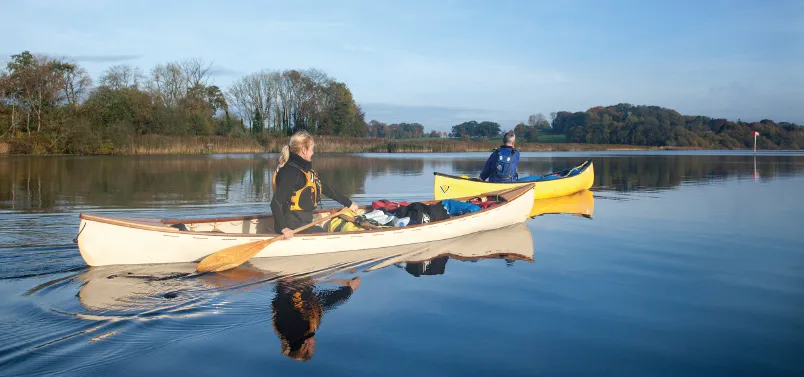![]()
The Blackwater River in Cork cuts a verdant corridor between beautiful wooded banks.
IRELAND has a remarkable array of inland waterways, and the best way to explore them fully is by open canoe. Whether you’re heading out for a few hours or for a multi-day adventure, the essence is to glide silently across rivers and lakes, journeying along the water and feeling like an integral part of the nature around you. It’s about the joy of simple strokes, darting kingfishers and evening campfires. If you want to travel in harmony with the planet, this is how to do it.
Despite being a country ripe with opportunity, open canoeing is not a well-developed pastime in Ireland. Enthusiasts from North America can’t understand it – we have interconnected lough, river and canal systems that stretch across the country, yet barely anybody out exploring them.
Canoeing isn’t a hard sport – you can head off on your own after learning just a few basic strokes. Do it solo, with friends or bring the whole family – the choice is yours. And if you have a touring or sea kayak, there’s nothing to stop you completing similar trips in those boats too.
The World’s First Boat
The canoe was the first true boat to be used by humans. The earliest known example is the Pesse canoe, which was uncovered in the Netherlands and dates from between 8200 and 7600 BC. Other examples have been found throughout history and in every part of the world, falling into three basic types: bark canoes, skin boats and wooden dugouts.
Meet like-minded enthusiasts at events such as the Ulster Canoe Festival each September.
Ireland’s Waterways at a Glance
Canoeists are spoilt for choice in Ireland. There are myriad loughs in every county, joined by a vast network of rivers and canals. Long-distance paddlers will find multiple cross-country itineraries, including the Shannon and Erne systems, which combine to offer over 350km of waterway between Counties Donegal and Limerick. Side links via the Royal and Grand Canals and the River Barrow extend the possibilities to Dublin and Waterford. The wide range of routes is a legacy of our history: before the advent of road transportation, Ireland’s waterways provided one of the primary means of shipping goods around the country.
Before heading out, choose what sort of water you want to explore. Rivers generally have some amount of flow, helping you cover ground more quickly, while tree-lined banks provide good shelter from the wind. Do your research carefully, though, to find out about any rapids or weirs along the route. Loughs can be great fun too, especially if there are plenty of islands to explore and camp on. Don’t underestimate the potential for bad weather on big lakes, however; in windy conditions you can find yourself wrestling to keep the boat straight, while waves start to break all around. Sheltered coastal inlets are another option, though you should have more experience – and a proper sea kayak – to venture out onto the open sea.
Canoes are great for touring waterside sites. Ross Castle, County Kerry.
Wherever you paddle inland, please be aware of the problems associated with invasive aquatic species. Ireland is currently battling invasions of several nonnative plants and animals, which spread disease and harm local wildlife. Some water bodies are already polluted with these organisms, while others remain pest-free. To avoid spreading the problem, all water users are asked to be extra vigilant when moving between different locations. Clean, wash and dry all your equipment thoroughly after each outing, checking all nooks and crannies for species that may be secretly hitchhiking on your boat. For more details, see www.invasivespeciesireland.com.
Boats and Paddles
There is some degree of semantic confusion in Ireland over the difference between a canoe and a kayak; most people use the term ‘canoeing’ to describe both. Yet there’s a significant difference between the two activities. A kayak has an enclosed cockpit that your feet slip inside. Kayakers sit down low and use a double-bladed paddle. Canoes – also known as Canadian or open canoes – are taller boats with a long top opening. Canoeists adopt an upright sitting or kneeling position, and propel themselves with a single-bladed paddle.
A Canoeist’s Prayer
God grant me the serenity to portage those sections I must, the courage to run the rapids I can, and the wisdom to know the difference.
Modern canoes can be made from a variety of material, but these days, most people start in a plastic boat. There is a whole range of different sizes too. If you’re thinking about paddling either tandem (with two people) or with a family, you’ll need a boat about 17ft long. Longer boats are quicker and easier to paddle straight, and hold more gear, though they’re susceptible to being blown off-course by the wind. If you’re planning to do a lot of soloing (paddling on your own) and prefer a more manoeuvrable craft, consider a boat as short as 13ft.
Apart from the boat, the other most important piece of kit is your paddle. These can be made from wood (most popular), plastic (cheap and cheerful) or carbon fibre (mainly for whitewater). Length is important here – a taller person needs a longer paddle. To calculate the right length for you, sit inside a canoe and measure the vertical distance from your nose to the waterline. This measurement should be the same as the distance from the paddle grip to the top of the blade.
Descending Lucan weir during the Liffey Descent, Ireland’s biggest whitewater race;
Other Equipment
It goes without saying that everybody who partakes in watersports should be a confident swimmer. Wear a buoyancy aid at all times, plus a helmet and wetsuit or drysuit if you’re tackling whitewater.
Other equipment will depend on the length of your excursion. For a day trip, a map, packed lunch, mobile phone and spare clothing may suffice. Overnight trips take rather more preparation, with camping gear and supplies packed into barrels or dry bags and secured inside the boat. Unless you can devise a circular route, shuttles between the start and finish points must be organised too. Two vehicles or a bike can be helpful here.
For overnight trips, pack your gear into barrels or dry bags secured inside the boat. Crom Estate, Upper Lough Erne;
Emergencies
In case of emergencies on the water, call 999 or 112 and ask for the police, ambulance or coastguard. The coastguard can also be contacted directly on VHF channel 16.
Battle of the rapids: in the heat of the action at the annual Mourne Whitewater Race, County Tyrone. (Graham Service)
Getting Started
The person who sits at the back of a canoe (in the stern) is the one who steers, while any passengers at the bow or in the centre provide the engine. It helps if everyone aboard knows a few strokes, but it’s essential for the stern paddler, the ‘J-stroke’ being the most important one to master. You will find numerous canoe tutorials online, but it’s invaluable having someone to show you the basics.
A perfect autumn day for a paddle on Lough Erne.
If you have no previous experience, begin by contacting someone who does. There are numerous clubs, outdoor centres and commercial operators around Ireland, all willing to help you get started. Either pay for a guided trip or instruction course, or join a club to...
